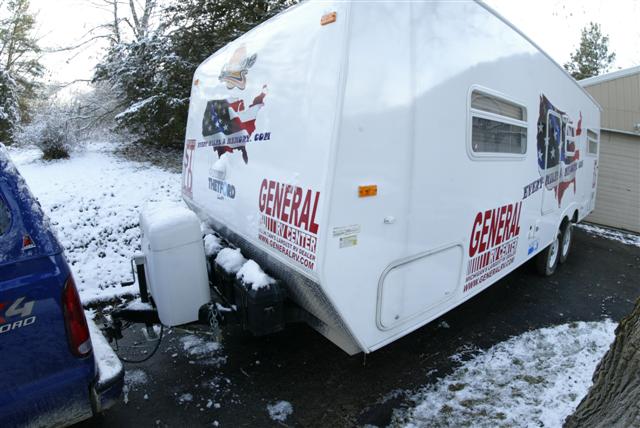| |


 



    








It is good to have an end to journey
towards, but it is the journey that matters in the end
~ Ursula K. LeGuin

I may not have gone
where I intended to go, but I think I have ended up where I intended to
be. - Douglas Adams
|
When we
realize our insignificance in this world,
it some how relieves the
pressures from society to succeed -
Cindy Bonish 04/07

Preparing Your
Camper for Spring Start-Up
Here is a quick check list to get you
started once Spring rolls around and those campgrounds and backroads
come a calling. This is just a start, and everyone probably has a
few things that they can add or subtract from this list.
A. To begin spring
startup on your RV:
-
*Remove
all protective covers and plugs. (Any duct tape adhesive left behind
may be removed easily with WD-40.)
-
*Wash
interior of your camper with mild soap and
lukewarm water.
-
*Turn
on all lights, replace bulbs as necessary.
-
*Check
operation of all appliances.
-
*Open
all windows & roof vents to air out
the inside (clean and wipe with warm water
and liquid dishwashing soap).
-
*Open
windows & shades
-
*Clean
exterior of your unit with mild soap and lukewarm water - use a streak
cleaner such as "Thetford Black Streak Remover"
-
*Lubricate
hinges, locks, and moving parts as necessary
-
*Reinstall
any batteries in clocks & smoke detectors
etc.
-
*Close
water taps
-
*Remove
moth balls and rodent bait from interior and exterior compartments.
(Be sure to remove from the vicinity of the hot water heater and
refrigerator gas burner assembly.)
B. Air Conditioner
-
*Remove
protective cover
-
*Remove
air shroud and check cooling coils, blower fan and motor
-
*Vacuum
or wash the condenser coil
-
*Clean
the cooling fins - Do not use a power washer
-
*Clean
air filters
-
*Clean
any dust from discharge air opening and ceiling grill
C. Refrigerator
-
*Open
the refrigerator side vent and look up to the roof vent and check for
nesting, remove debris if necessary. Remember to remove mothballs from
the vicinity of the gas burner assembly
-
*Wipe out the
inside of the refrigerator and freezer with warm water and soap before
turning the unit back on
-
*Check your owners
manual to see if it lists any specific things that need to be done
before turning the unit back on from its winter storage
D. Water System
-
*Close
pressure relief valve on water heater. Remember to remove mothballs
from the vicinity of the gas burner assembly first
-
*Close
all drain valves and faucets (including shower head)
-
*Flush
out RV antifreeze by running water through entire system
-
*Reinstall
drain plug (removed in the winterization process)
-
*Add
a few ounces of baking soda to the tank, drive around to mix solution,
then drain and refill
-
*If
your water has a bad taste or strange odor, take these steps to kill
bacteria that may be present:
a. Fill fresh water tank half way with clean, fresh water.
b. Mix 1/4 cup of household bleach for every 15 gallons of tank
capacity in a container with a gallon or two of clean water and pour
this mixture into the water tank.
c. Top off the water tank with fresh water. Go for a drive to
mix the solution.
d. Pump water through each faucet so that all the lines are
filled with the water/bleach mixture from the tank. Usually, running a
quart of water out each faucet is adequate.
e. The hot-water tank holds at least 6 gallons of water. Run
the hot water faucets until this much solution has passed to insure
that the old water has been purged from the hot-water tank, and it is
now filled with the water/bleach solution from the water tank.
f. Let the water stand for several hours.
g. Drain the entire water system, hot water tank included.
h. To remove the bleach odor, mix 1/2 cup of baking soda with a
gallon of water and pour into the freshwater tank.
i. Fill the tank completely and pump this solution through the
water heater and rest of the water lines. This solution can sit in the
system for a few days. Driving the rig around the block will slosh
water around and thoroughly clean the tank.
j. Drain the entire system and refill with fresh, clean water.
E. Awning
-
*Open awning and
brush off any debris that has settled from the winter storage
-
*Take a small piece
of rubber (Vacuum Line works great!) and clean out the gutters along
the sides of the RV
-
*Check
for damage or mildew on
the awning
-
*Clean the awning
with Thetford Awning Cleaner
F. Tires
-
*Inspect
tires for wear
a. Tires should be replaced if tread is worn down to 1/16 inch
or if tread sidewall is cracked, cut or flaking
b. Select tires of the same construction, load range and size
-
*Re-inflate
tires to the proper pressure
-
*Remove
trailer from jacks or blocks
-
*Check the lug nuts
with a torque wrench to make sure they are at the proper setting
before towing out of the storage lot or driveway
-
*For
safety sake, after a few miles traveling on
your first trip in the Spring, check the lug nuts to be sure they are
still tight (What's it going to hurt?)
G. Furnace
-
*Remove
cover
-
*Check
for insect nests and lint accumulation
-
*Turn
on the electric power and turn on the thermostats (to check for
operation).
-
*Turn
on the main gas supply to the furnace
H. LP System
-
*Open
the main LP-gas valve and check the LP gas system for leaks (Use soapy
water or commercial leak detector solution and brush to check each gas
line connection)
-
*A
rusted tank will not be filled by an LP gas attendant, sand and
repaint if necessary
-
*Consult
a trained LP-gas technician to correct any leakage
problems
I. Electrical System
-
*Check
for short circuit between positive and negative battery cables with
circuit tester or ohm-meter. If no short
circuit is detected then reconnect all batteries and reset any
electronic clocks/items etc
-
*Once batteries
have been re-attached, make a check that everything is working
properly so you wont be surprised on the first camping trip
J. Roof Vent Seals
-
*Look
for signs of deterioration. Reseal and caulk
where needed with sealing compound (also
check the caulk around the windows.)
-
Note: Do Not walk
on roof without proper support to distribute weight
unless your roof is designed to be walked on
Sources
Sunline's Service and Production Teams
"Winterizing" - Chapter 12 - Woodall's RV Owner's Handbook
"Preparing Your RV for Storage" - Hans J. Gugger - Trailer Life
magazine.
"RV Repair & Maintenance Manual" - Trailer Life - Edited by Bob
Livingston
"Putting Your Wheels on Ice" - Michael Packard - Trailer Life - Dec.
1995
Every
Miles A Memory
Return to Top of Page

Need Unlimited photo storage- FREE Trial of Smugmug
|
|





